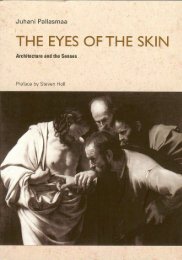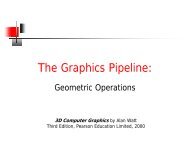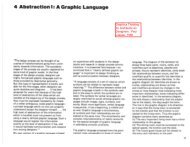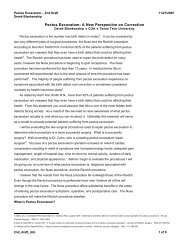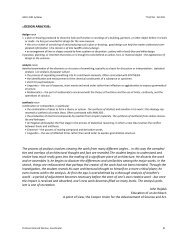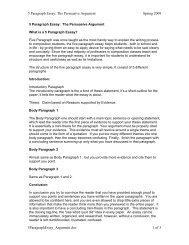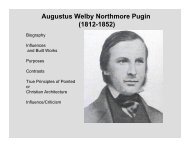Brunelleschi's mirror, Alberti's window, and Galileo's' perspective tube'
Brunelleschi's mirror, Alberti's window, and Galileo's' perspective tube'
Brunelleschi's mirror, Alberti's window, and Galileo's' perspective tube'
- No tags were found...
Create successful ePaper yourself
Turn your PDF publications into a flip-book with our unique Google optimized e-Paper software.
SAMUEL Y. EDGERTONseries of twenty-four plates illustrating special problems of chiaroscuro,including several remarkable engravings of shaded spheres withboth raised protuberances <strong>and</strong> recessed channels (Figure 12).Let us for a moment take leaveFigure 12of Florence <strong>and</strong> look in on JacobeanLondon during the summer of1609, where we encounter Galileo’sscientific contemporary, ThomasHarriot (1560-1621), who has justprocured a fascinating newinstrument invented the yearbefore in Holl<strong>and</strong>, which he calleda ‘<strong>perspective</strong> tube,’ <strong>and</strong> which, ofcourse, we now call the telescope.The Dutch inventors had thoughtthat the new device would be mostuseful to sailors for spottingdistant ships at sea, or to militarycomm<strong>and</strong>ers for discerning far-offenemy installations, but Harriotdid the novel thing of turning iton the moon. He even made anextant drawing of the moon asseen through his ‘<strong>perspective</strong> tube’(Figure 13). Unfortunately, he added no explanation save the (Juliancalendar) date <strong>and</strong> time of his observation: “1609, July 26,hor.9p.m.,...The [first quarter] 5 dayes old.” In any case – <strong>and</strong> thereason why he is hardly remembered in the history of astronomy– Harriot’s crude sketch reveals nothing new.Europeans of his time still had no reason to doubt Aristotle’sdefinition of the moon as a perfect sphere, the prototypical form ofall planets <strong>and</strong> stars in the cosmos. Christian doctrine added tothis euphoric image by having the moon symbolize the Virgin’sImmaculate Conception. ‘Pure as the moon’ became a commonplaceexpression for Mary, implying that the universe, like her, wasincorruptible, that God would not have created the moon or anyheavenly body in another shape. Renaissance artists, especially thoseserving zealous Catholic patrons, frequently depicted the Virginst<strong>and</strong>ing on such a moon, as did Bartolomé Estabán Murillo (1617-82) well into the seventeenth century, especially in Spain (Figure 14). Wesee her here in one of many paintings Murillo did of the subject,poised upon a ball marbled like translucent alabaster but with ahighly polished, utterly smooth surface.In Thomas Harriot’s Engl<strong>and</strong>, anti-Aristotelian Francis Bacon(1561-1626) had concluded that the lunar body was not solid atall, but rather composed of some unexplained ‘vapour.’ Harriot’s166 História, Ciências, Saúde – Manguinhos, Rio de Janeiro





